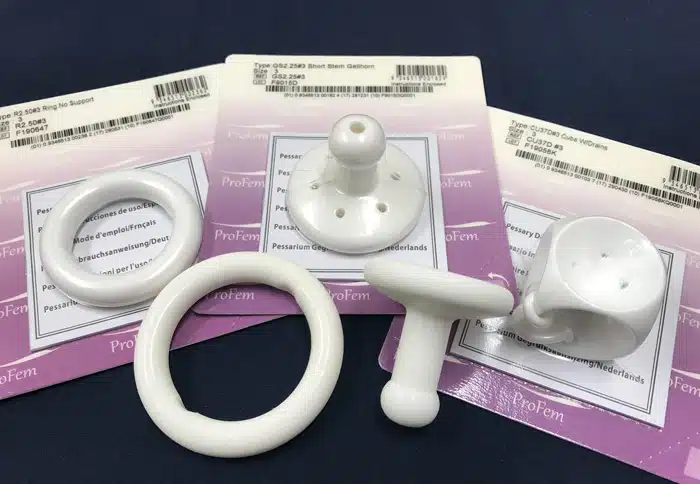Are you a woman with symptoms of vaginal bulging/heaviness/protrusion? Do you have a prolapse but want to avoid surgery? Urinary leakage that hasn’t completely resolved with pelvic floor exercises?
A pessary may be the answer.
What is a Pessary, and What are They Used For?
A pessary is a silicone device that fits into the vagina to help support prolapse of the pelvic organs or to help improve urinary incontinence by supporting the urethra.
Pessaries provide structural support by repositioning the pelvic organs into a more normal anatomical position, which can help alleviate feelings of discomfort associated with prolapse.
Pessaries are an evidence-based conservative, low-risk measure to help support the prolapse, and their use is akin to wearing a knee guard if you had a ligament issue in your knee. A pessary may be worn during activities that might typically aggravate prolapse or leakage symptoms, or it may be necessary to wear it all the time.
There are different shapes and styles of pessaries, such as rings (with or without a knob), cubes, or Gellhorns to name a few (see image). Your Physiotherapist will talk through your history and symptoms, then complete a thorough vaginal examination to determine the best style and course of action for you.

What Does Wearing a Pessary Feel Like?
A well-fitted pessary should feel comfortable and like it’s not even there (similar to a tampon when it’s sitting in the correct position). If you feel the pessary keeps slipping down, or you get aching or discomfort, please let your Physiotherapist know as you might need a different size or style.
Who Can Use Pessaries?
Vaginal pessaries can be used in:
- women with mild, moderate, or (some cases of) severe pelvic organ prolapse
- women who would like to try conservative prolapse management or avoid surgery
- postnatal women who require some vaginal support to return to exercise and activity
- women with stress urinary incontinence which may not have resolved with pelvic floor muscle exercises
Are there any Side Effects?
Some increase in vaginal discharge is expected (clear/creamy discharge is normal). Vaginal irritation is another possible side effect and women who are past menopause may need to use oestrogen cream.
Occasionally, women can report a new onset of urinary Ieakage with pessary use, as lifting of the pelvic organs can sometimes unmask stress urinary incontinence. In this case, your Physiotherapist will help you find the best pessary style and solution.
Most of the potential side effects of using a pessary are very low risk and can be managed well with regular self-care and follow-up. However, if you have yellow/green vaginal discharge or any bleeding, bad vaginal odour, or you are unable to empty your bladder or bowel, remove the pessary immediately if you are able and contact your health care provider.
Do Pessaries Have to be Taken out for Sex?
A ring pessary may be left in place for sexual intercourse. Other styles such as the cube or Gellhorn have to be removed beforehand.
What Does Self-Management of a Pessary Involve?
Your Physiotherapist will teach you how to remove, clean and re-insert your pessary. Some styles can be left in for a week or longer, and others need to be removed daily.
Self-management of your pessary is the ideal in order to maintain healthy vaginal tissue and to reduce any adverse side effects. However, you can certainly still use a pessary even if you are unable to manage it on your own, and your Physiotherapist will discuss your follow-up schedule with you. It is important to attend your follow-up appointments.
What is the Follow-Up Plan?
After the initial fitting your Physiotherapist will review you within 1-2 weeks to check the sizing of your pessary and its effect. In addition, self-care of the pessary will be explained and practised with you. You should then be reviewed at 4-6 months following the initial fitting, then every 12 months thereafter. Pessaries should be replaced annually. Sometimes a different size or shape of pessary will have to be fitted, as things may improve or change over time.
You should also have a yearly check-up with your GP or Gynaecologist for a speculum examination. It is important to attend all follow-up appointments to ensure your vaginal tissue remains healthy.
Are Pessaries a Long-Term Treatment Option? Will I Have to Wear a Pessary Forever?
Pessaries are a safe, long-term management option for pelvic organ prolapse. Some women happily use pessaries for years. Other women choose to just wear their pessary for exercise and physical activity. Many postnatal women in the few months after delivery find that they are able to wean off using pessaries completely as their body recovers and changes over time.
Ultimately, whether or not you should wear a pessary long-term is up to you and based on your symptoms. If there is a need for surgical intervention, we have a wonderful network of specialists that we work with.
If a pessary sounds like a treatment option you would like to try, book in with one of our pelvic Physiotherapists for an individualised assessment.
Other helpful resources:

